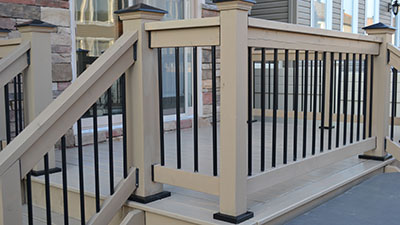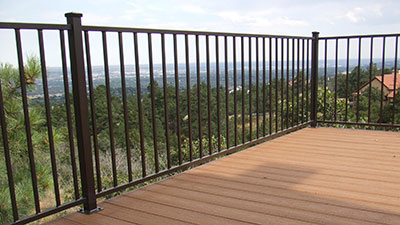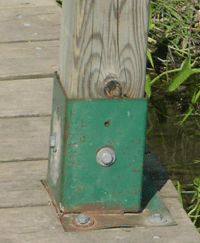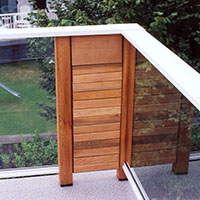different types of deck railing Post anchors
The rise in popularity of deck railing post anchors is no surprise.
Anyone who has experienced the ease and speed of installation, eliminating notching of decking and tricky carpentry skills, or all the hardware required for setting posts into joists knows this intimately.

Luxurious Looking Surface Mounted Post Anchors
Today's options for attaching posts to deck surfaces
The idea of quickly installing a post where you want, on either a wood framed deck, concrete or even stone surface is appealing.
With the right post anchors or hardware you can get some impressive aesthetic results and greatly reduce the potential for rot. That's because the bottom of the wood post is elevated above the wet surface, keeping it higher - and drier.
There can be some pros and cons however.
We'll discuss them all as they relate to aluminum posts, pvc and composite - and of course wood.
That's Nice - What Did They Use On That Deck?
This particular deck used the Titan Post Anchor, the most popular surface mounted anchor around.
It's an internal anchor - completely hidden from view and strong enough for use in code compliant residential guard rail applications when properly installed. It's available at our store.
Or see the manufacturer's growing network of local stores on their Dealer Map.
Bolt Down Aluminum Metal Posts
The most common railings that utilize surface mounted posts tend to be aluminum railings or some of the PVC and composite railings.
Here we see typical aluminum posts bolted to the deck surface through a base welded to the post.

The fasteners and base are visible but the entire railing becomes quite strong as long as both ends of the railing are tied in to the wall of the home. Long unsupported runs of railing will tend to be weaker unless post support brackets are used.
Wood Post Options
Securing a wood post to a deck surface has always been a challenging problem to solve. There are a variety of products available but where one succeeds in offering a lot of strength, it tends to lack good aesthetics and vice verse.
Plastic External Shell
Here is a plastic molded post base that fits externally around a 4x4. For simple jobs around the house they work quite well and are cheap.
But if
you need to build an real "guardrail" that can meet the horizontal load
requirements in the building code, exercise caution as these things are useless for that purpose.
However, for a non-life threatening
application like a deck below 24" above grade, this kind of an external anchor works
fine.
It's highly visible and not at all what you would ever want to have on a beautiful backyard deck.
Injection Molded Plastic Anchors

Cheap, But Poor Performance And Not Attractive
Metal External Shell
Here is a
stronger external metal post anchor but it is not the type of thing most
homeowners would want to see at the bottom of each of their deck posts.
Aside
from the dominance of the anchor itself, the bolts and brackets are
completely visible. These anchors are better suited for applications
where a nicely finished product is not required.
Some homeowners use these anchors, even after spending thousands of dollars on renovation and deck upgrades.
Not only are these two examples not engineered for railing anchors, but this doesn't look that great either. And eventually these anchors end up looking rusted and beaten up.
Large Metal External Post Anchor

Stronger, But Ugly
Internal Post Anchor
This is a proprietary 4x4 wood and aluminum rail system by an innovative company called DekTek. It uses a single lag screw and a formed base to create beautiful appearance.
Very
clean looking - the anchor and fasteners are completely hidden. If all
the railing is tied back to the house and there are no unsupported runs,
it can be quite strong.
The only downside to this surface
mounted post anchor is that it really should be used with their railing
system to be strong enough to meet the code. It is not as strong if you
try to install a few posts by themselves.
Hidden Lag Screw Post Anchor

no notching, multiples surfaces, reduced rotting
There is no question that these three benefits weigh heavily in favor of the wood post surface mounted railing anchors. However, they typically are limited to certain post spacing distances such as six feet in order to meet residential code standards.
This may be a reason for you not to use them. You may have a project that you want to use greater post spans. Then what?
You will have to use the traditional construction and framing methods. For those interested, we have a great series of detailed articles with full illustrations for you to enjoy.
Home > Deck Railings > Deck Railing Post Anchors




























